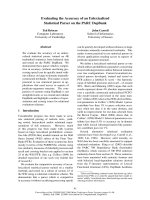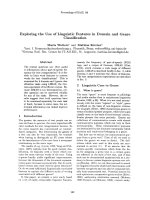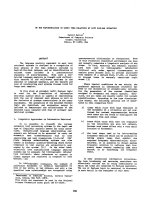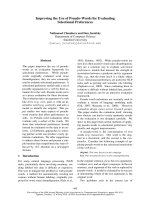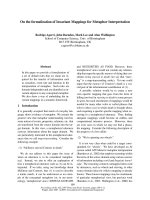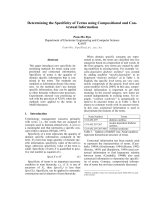Báo cáo khoa học: "On the use of Comparable Corpora to improve SMT performance" ppt
Bạn đang xem bản rút gọn của tài liệu. Xem và tải ngay bản đầy đủ của tài liệu tại đây (103.2 KB, 8 trang )
Proceedings of the 12th Conference of the European Chapter of the ACL, pages 16–23,
Athens, Greece, 30 March – 3 April 2009.
c
2009 Association for Computational Linguistics
On the use of Comparable Corpora to improve SMT performance
Sadaf Abdul-Rauf and Holger Schwenk
LIUM, University of Le Mans, FRANCE
Abstract
We present a simple and effective method
for extracting parallel sentences from
comparable corpora. We employ a sta-
tistical machine translation (SMT) system
built from small amounts of parallel texts
to translate the source side of the non-
parallel corpus. The target side texts are
used, along with other corpora, in the lan-
guage model of this SMT system. We
then use information retrieval techniques
and simple filters to create French/English
parallel data from a comparable news cor-
pora. We evaluate the quality of the ex-
tracted data by showing that it signifi-
cantly improves the performance of an
SMT systems.
1 Introduction
Parallel corpora have proved be an indispens-
able resource in Statistical Machine Translation
(SMT). A parallel corpus, also called bitext, con-
sists in bilingual texts aligned at the sentence level.
They have also proved to be useful in a range of
natural language processing applications like au-
tomatic lexical acquisition, cross language infor-
mation retrieval and annotation projection.
Unfortunately, parallel corpora are a limited re-
source, with insufficient coverage of many lan-
guage pairs and application domains of inter-
est. The performance of an SMT system heav-
ily depends on the parallel corpus used for train-
ing. Generally, more bitexts lead to better per-
formance. Current resources of parallel corpora
cover few language pairs and mostly come from
one domain (proceedings of the Canadian or Eu-
ropean Parliament, or of the United Nations). This
becomes specifically problematic when SMT sys-
tems trained on such corpora are used for general
translations, as the language jargon heavily used in
these corpora is not appropriate for everyday life
translations or translations in some other domain.
One option to increase this scarce resource
could be to produce more human translations, but
this is a very expensive option, in terms of both
time and money. In recent work less expensive but
very productive methods of creating such sentence
aligned bilingual corpora were proposed. These
are based on generating “parallel” texts from al-
ready available “almost parallel” or “not much
parallel” texts. The term “comparable corpus” is
often used to define such texts.
A comparable corpus is a collection of texts
composed independently in the respective lan-
guages and combined on the basis of similarity
of content (Yang and Li, 2003). The raw mate-
rial for comparable documents is often easy to ob-
tain but the alignment of individual documents is a
challenging task (Oard, 1997). Multilingual news
reporting agencies like AFP, Xinghua, Reuters,
CNN, BBC etc. serve to be reliable producers
of huge collections of such comparable corpora.
Such texts are widely available from LDC, in par-
ticular the Gigaword corpora, or over the WEB
for many languages and domains, e.g. Wikipedia.
They often contain many sentences that are rea-
sonable translations of each other, thus potential
parallel sentences to be identified and extracted.
There has been considerable amount of work on
bilingual comparable corpora to learn word trans-
lations as well as discovering parallel sentences.
Yang and Lee (2003) use an approach based on
dynamic programming to identify potential paral-
lel sentences in title pairs. Longest common sub
sequence, edit operations and match-based score
functions are subsequently used to determine con-
fidence scores. Resnik and Smith (2003) pro-
pose their STRAND web-mining based system
and show that their approach is able to find large
numbers of similar document pairs.
Works aimed at discovering parallel sentences
16
French: Au total, 1,634 million d’
´
electeurs doivent d
´
esigner les 90 d
´
eput
´
es de la prochaine l
´
egislature
parmi 1.390 candidats pr
´
esent
´
es par 17 partis, dont huit sont repr
´
esent
´
es au parlement.
Query: In total, 1,634 million voters will designate the 90 members of the next parliament among 1.390
candidates presented by 17 parties, eight of which are represented in parliament.
Result: Some 1.6 million voters were registered to elect the 90 members of the legislature from 1,390
candidates from 17 parties, eight of which are represented in parliament, several civilian organisations
and independent lists.
French: ”Notre implication en Irak rend possible que d’autres pays membres de l’Otan, comme
l’Allemagne par exemple, envoient un plus gros contingent” en Afghanistan, a estim
´
e M.Belka au cours
d’une conf
´
erence de presse.
Query: ”Our involvement in Iraq makes it possible that other countries members of NATO, such
as Germany, for example, send a larger contingent in Afghanistan, ”said Mr.Belka during a press
conference.
Result: ”Our involvement in Iraq makes it possible for other NATO members, like Germany for
example, to send troops, to send a bigger contingent to your country, ”Belka said at a press conference,
with Afghan President Hamid Karzai.
French: De son c
ˆ
ot
´
e, Mme Nicola Duckworth, directrice d’Amnesty International pour l’Europe et
l’Asie centrale, a d
´
eclar
´
e que les ONG demanderaient
`
a M.Poutine de mettre fin aux violations des
droits de l’Homme dans le Caucase du nord.
Query: For its part, Mrs Nicole Duckworth, director of Amnesty International for Europe and Central
Asia, said that NGOs were asking Mr Putin to put an end to human rights violations in the northern
Caucasus.
Result: Nicola Duckworth, head of Amnesty International’s Europe and Central Asia department, said
the non-governmental organisations (NGOs) would call on Putin to put an end to human rights abuses
in the North Caucasus, including the war-torn province of Chechnya.
Figure 1: Some examples of a French source sentence, the SMT translation used as query and the poten-
tial parallel sentence as determined by information retrieval. Bold parts are the extra tails at the end of
the sentences which we automatically removed.
include (Utiyama and Isahara, 2003), who use
cross-language information retrieval techniques
and dynamic programming to extract sentences
from an English-Japanese comparable corpus.
They identify similar article pairs, and then, treat-
ing these pairs as parallel texts, align their sen-
tences on a sentence pair similarity score and use
DP to find the least-cost alignment over the doc-
ument pair. Fung and Cheung (2004) approach
the problem by using a cosine similarity measure
to match foreign and English documents. They
work on “very non-parallel corpora”. They then
generate all possible sentence pairs and select the
best ones based on a threshold on cosine simi-
larity scores. Using the extracted sentences they
learn a dictionary and iterate over with more sen-
tence pairs. Recent work by Munteanu and Marcu
(2005) uses a bilingual lexicon to translate some
of the words of the source sentence. These trans-
lations are then used to query the database to find
matching translations using information retrieval
(IR) techniques. Candidate sentences are deter-
mined based on word overlap and the decision
whether a sentence pair is parallel or not is per-
formed by a maximum entropy classifier trained
on parallel sentences. Bootstrapping is used and
the size of the learned bilingual dictionary is in-
creased over iterations to get better results.
Our technique is similar to that of (Munteanu
and Marcu, 2005) but we bypass the need of the
bilingual dictionary by using proper SMT transla-
tions and instead of a maximum entropy classifier
we use simple measures like the word error rate
(WER) and the translation error rate (TER) to de-
cide whether sentences are parallel or not. Using
the full SMT sentences, we get an added advan-
tage of being able to detect one of the major errors
of this technique, also identified by (Munteanu and
Marcu, 2005), i.e, the cases where the initial sen-
tences are identical but the retrieved sentence has
17
a tail of extra words at sentence end. We try to
counter this problem as detailed in 4.1.
We apply this technique to create a parallel cor-
pus for the French/English language pair using the
LDC Gigaword comparable corpus. We show that
we achieve significant improvements in the BLEU
score by adding our extracted corpus to the already
available human-translated corpora.
This paper is organized as follows. In the next
section we first describe the baseline SMT system
trained on human-provided translations only. We
then proceed by explaining our parallel sentence
selection scheme and the post-processing. Sec-
tion 4 summarizes our experimental results and
the paper concludes with a discussion and perspec-
tives of this work.
2 Baseline SMT system
The goal of SMT is to produce a target sentence
e from a source sentence f . Among all possible
target language sentences the one with the highest
probability is chosen:
e
∗
= arg max
e
Pr(e|f) (1)
= arg max
e
Pr(f |e) Pr(e) (2)
where Pr(f|e) is the translation model and
Pr(e) is the target language model (LM). This ap-
proach is usually referred to as the noisy source-
channel approach in SMT (Brown et al., 1993).
Bilingual corpora are needed to train the transla-
tion model and monolingual texts to train the tar-
get language model.
It is today common practice to use phrases as
translation units (Koehn et al., 2003; Och and
Ney, 2003) instead of the original word-based ap-
proach. A phrase is defined as a group of source
words
˜
f that should be translated together into a
group of target words ˜e. The translation model in
phrase-based systems includes the phrase transla-
tion probabilities in both directions, i.e. P(˜e|
˜
f )
and P (
˜
f |˜e). The use of a maximum entropy ap-
proach simplifies the introduction of several addi-
tional models explaining the translation process :
e
∗
= arg max P r(e|f )
= arg max
e
{exp(
i
λ
i
h
i
(e, f ))} (3)
The feature functions h
i
are the system mod-
els and the λ
i
weights are typically optimized to
maximize a scoring function on a development
SMT baseline
system
phrase
table
3.3G
4−gram
LM
Fr En
automatic
translations
En
words
words
275M
up to
Fr En
human translations
words
116M
up to
Figure 2: Using an SMT system used to translate
large amounts of monolingual data.
set (Och and Ney, 2002). In our system fourteen
features functions were used, namely phrase and
lexical translation probabilities in both directions,
seven features for the lexicalized distortion model,
a word and a phrase penalty, and a target language
model.
The system is based on the Moses SMT
toolkit (Koehn et al., 2007) and constructed as fol-
lows. First, Giza++ is used to perform word align-
ments in both directions. Second, phrases and
lexical reorderings are extracted using the default
settings of the Moses SMT toolkit. The 4-gram
back-off target LM is trained on the English part
of the bitexts and the Gigaword corpus of about
3.2 billion words. Therefore, it is likely that the
target language model includes at least some of
the translations of the French Gigaword corpus.
We argue that this is a key factor to obtain good
quality translations. The translation model was
trained on the news-commentary corpus (1.56M
words)
1
and a bilingual dictionary of about 500k
entries.
2
This system uses only a limited amount
of human-translated parallel texts, in comparison
to the bitexts that are available in NIST evalua-
tions. In a different versions of this system, the
Europarl (40M words) and the Canadian Hansard
corpus (72M words) were added.
In the framework of the EuroMatrix project, a
test set of general news data was provided for the
shared translation task of the third workshop on
1
Available at />shared-task.html
2
The different conjugations of a verb and the singular and
plural form of adjectives and nouns are counted as multiple
entries.
18
EN
SMT
FR
used as queries
per day articles
candidate sentence pairs
parallel
sentences
+−5 day articles
from English Gigaword
English
translations
Gigaword
French
174M words
133M words
tail
removal
sentences with
extra words at ends
+
24.3M words
parallel
number / table
comparison
length
removing
WER/TER
26.8M words
Figure 3: Architecture of the parallel sentence extraction system.
SMT (Callison-Burch et al., 2008), called new-
stest2008 in the following. The size of this cor-
pus amounts to 2051 lines and about 44 thousand
words. This data was randomly split into two parts
for development and testing. Note that only one
reference translation is available. We also noticed
several spelling errors in the French source texts,
mainly missing accents. These were mostly auto-
matically corrected using the Linux spell checker.
This increased the BLEU score by about 1 BLEU
point in comparison to the results reported in the
official evaluation (Callison-Burch et al., 2008).
The system tuned on this development data is used
translate large amounts of text of French Gigaword
corpus (see Figure 2). These translations will be
then used to detect potential parallel sentences in
the English Gigaword corpus.
3 System Architecture
The general architecture of our parallel sentence
extraction system is shown in figure 3. Start-
ing from comparable corpora for the two lan-
guages, French and English, we propose to trans-
late French to English using an SMT system as de-
scribed above. These translated texts are then used
to perform information retrieval from the English
corpus, followed by simple metrics like WER and
TER to filter out good sentence pairs and even-
tually generate a parallel corpus. We show that a
parallel corpus obtained using this technique helps
considerably to improve an SMT system.
We shall also be trying to answer the following
question over the course of this study: do we need
to use the best possible SMT systems to be able to
retrieve the correct parallel sentences or any ordi-
nary SMT system will serve the purpose ?
3.1 System for Extracting Parallel Sentences
from Comparable Corpora
LDC provides large collections of texts from mul-
tilingual news reporting agencies. We identified
agencies that provided news feeds for the lan-
guages of our interest and chose AFP for our
study.
3
We start by translating the French AFP texts to
English using the SMT systems discussed in sec-
tion 2. In our experiments we considered only
the most recent texts (2002-2006, 5.5M sentences;
about 217M French words). These translations are
then treated as queries for the IR process. The de-
sign of our sentence extraction process is based on
the heuristic that considering the corpus at hand,
we can safely say that a news item reported on
day X in the French corpus will be most proba-
bly found in the day X-5 and day X+5 time pe-
riod. We experimented with several window sizes
and found the window size of ±5 days to be the
most accurate in terms of time and the quality of
the retrieved sentences.
Using the ID and date information for each sen-
tence of both corpora, we first collect all sentences
from the SMT translations corresponding to the
same day (query sentences) and then the corre-
sponding articles from the English Gigaword cor-
3
LDC corpora LDC2007T07 (English) and LDC2006T17
(French).
19
pus (search space for IR). These day-specific files
are then used for information retrieval using a ro-
bust information retrieval system. The Lemur IR
toolkit (Ogilvie and Callan, 2001) was used for
sentence extraction. The top 5 scoring sentences
are returned by the IR process. We found no evi-
dence that retrieving more than 5 top scoring sen-
tences helped get better sentences. At the end of
this step, we have for each query sentence 5 po-
tentially matching sentences as per the IR score.
The information retrieval step is the most time
consuming task in the whole system. The time
taken depends upon various factors like size of the
index to search in, length of the query sentence
etc. To give a time estimate, using a ±5 day win-
dow required 9 seconds per query vs 15 seconds
per query when a ±7 day window was used. The
number of results retrieved per sentence also had
an impact on retrieval time with 20 results tak-
ing 19 seconds per query, whereas 5 results taking
9 seconds per query. Query length also affected
the speed of the sentence extraction process. But
with the problem at we could differentiate among
important and unimportant words as nouns, verbs
and sometimes even numbers (year, date) could be
the keywords. We, however did place a limit of
approximately 90 words on the queries and the in-
dexed sentences. This choice was motivated by the
fact that the word alignment toolkit Giza++ does
not process longer sentences.
A Krovetz stemmer was used while building the
index as provided by the toolkit. English stop
words, i.e. frequently used words, such as “a” or
“the”, are normally not indexed because they are
so common that they are not useful to query on.
The stop word list provided by the IR Group of
University of Glasgow
4
was used.
The resources required by our system are min-
imal : translations of one side of the comparable
corpus. We will be showing later in section 4.2
of this paper that with an SMT system trained on
small amounts of human-translated data we can
’retrieve’ potentially good parallel sentences.
3.2 Candidate Sentence Pair Selection
Once we have the results from information re-
trieval, we proceed on to decide whether sentences
are parallel or not. At this stage we choose the
best scoring sentence as determined by the toolkit
4
/>linguistic utils/stop words
and pass the sentence pair through further filters.
Gale and Church (1993) based their align program
on the fact that longer sentences in one language
tend to be translated into longer sentences in the
other language, and that shorter sentences tend to
be translated into shorter sentences. We also use
the same logic in our initial selection of the sen-
tence pairs. A sentence pair is selected for fur-
ther processing if the length ratio is not more than
1.6. A relaxed factor of 1.6 was chosen keeping
in consideration the fact that French sentences are
longer than their respective English translations.
Finally, we discarded all sentences that contain a
large fraction of numbers. Typically, those are ta-
bles of sport results that do not carry useful infor-
mation to train an SMT.
Sentences pairs conforming to the previous cri-
teria are then judged based on WER (Levenshtein
distance) and translation error rate (TER). WER
measures the number of operations required to
transform one sentence into the other (insertions,
deletions and substitutions). A zero WER would
mean the two sentences are identical, subsequently
lower WER sentence pairs would be sharing most
of the common words. However two correct trans-
lations may differ in the order in which the words
appear, something that WER is incapable of tak-
ing into account as it works on word to word ba-
sis. This shortcoming is addressed by TER which
allows block movements of words and thus takes
into account the reorderings of words and phrases
in translation (Snover et al., 2006). We used both
WER and TER to choose the most suitable sen-
tence pairs.
4 Experimental evaluation
Our main goal was to be able to create an addi-
tional parallel corpus to improve machine transla-
tion quality, especially for the domains where we
have less or no parallel data available. In this sec-
tion we report the results of adding these extracted
parallel sentences to the already available human-
translated parallel sentences.
We conducted a range of experiments by adding
our extracted corpus to various combinations of al-
ready available human-translated parallel corpora.
We experimented with WER and TER as filters to
select the best scoring sentences. Generally, sen-
tences selected based on TER filter showed better
BLEU and TER scores than their WER counter
parts. So we chose TER filter as standard for
20
18.5
19
19.5
20
20.5
21
21.5
22
0 2 4 6 8 10 12 14 16
BLEU score
French words for training [M]
news
bitexts only
TER filter
WER
Figure 4: BLEU scores on the Test data using an
WER or TER filter.
our experiments with limited amounts of human
translated corpus. Figure 4 shows this WER vs
TER comparison based on BLEU and TER scores
on the test data in function of the size of train-
ing data. These experiments were performed with
only 1.56M words of human-provided translations
(news-commentary corpus).
4.1 Improvement by sentence tail removal
Two main classes of errors common in such
tasks: firstly, cases where the two sentences share
many common words but actually convey differ-
ent meaning, and secondly, cases where the two
sentences are (exactly) parallel except at sentence
ends where one sentence has more information
than the other. This second case of errors can be
detected using WER as we have both the sentences
in English. We detected the extra insertions at the
end of the IR result sentence and removed them.
Some examples of such sentences along with tails
detected and removed are shown in figure 1. This
resulted in an improvement in the SMT scores as
shown in table 1.
This technique worked perfectly for sentences
having TER greater than 30%. Evidently these
are the sentences which have longer tails which
result in a lower TER score and removing them
improves performance significantly. Removing
sentence tails evidently improved the scores espe-
cially for larger data, for example for the data size
of 12.5M we see an improvement of 0.65 and 0.98
BLEU points on dev and test data respectively and
1.00 TER points on test data (last line table 1).
The best BLEU score on the development data
is obtained when adding 9.4M words of automat-
ically aligned bitexts (11M in total). This corre-
Limit Word BLEU BLEU TER
TER tail Words Dev Test Test
filter removal (M) data data data
0 1.56 19.41 19.53 63.17
10
no
1.58
19.62 19.59 63.11
yes 19.56 19.51 63.24
20
no
1.7
19.76 19.89 62.49
yes 19.81 19.75 62.80
30
no
2.1
20.29 20.32 62.16
yes 20.16 20.22 62.02
40
no
3.5
20.93 20.81 61.80
yes 21.23 21.04 61.49
45
no
4.9
20.98 20.90 62.18
yes 21.39 21.49 60.90
50
no
6.4
21.12 21.07 61.31
yes 21.70 21.70 60.69
55
no
7.8
21.30 21.15 61.23
yes 21.90 21.78 60.41
60
no
9.8
21.42 20.97 61.46
yes 21.96 21.79 60.33
65
no
11
21.34 21.20 61.02
yes 22.29 21.99 60.10
70
no
12.2
21.21 20.84 61.24
yes 21.86 21.82 60.24
Table 1: Effect on BLEU score of removing extra
sentence tails from otherwise parallel sentences.
sponds to an increase of about 2.88 points BLEU
on the development set and an increase of 2.46
BLEU points on the test set (19.53 → 21.99) as
shown in table 2, first two lines. The TER de-
creased by 3.07%.
Adding the dictionary improves the baseline
system (second line in Table 2), but it is not nec-
essary any more once we have the automatically
extracted data.
Having had very promising results with our pre-
vious experiments, we proceeded onto experimen-
tation with larger human-translated data sets. We
added our extracted corpus to the collection of
News-commentary (1.56M) and Europarl (40.1M)
bitexts. The corresponding SMT experiments
yield an improvement of about 0.2 BLEU points
on the Dev and Test set respectively (see table 2).
4.2 Effect of SMT quality
Our motivation for this approach was to be able
to improve SMT performance by ’creating’ paral-
lel texts for domains which do not have enough
or any parallel corpora. Therefore only the news-
21
total BLEU score TER
Bitexts words Dev Test Test
News 1.56M 19.41 19.53 63.17
News+Extracted 11M 22.29 21.99 60.10
News+dict 2.4M 20.44 20.18 61.16
News+dict+Extracted 13.9M 22.40 21.98 60.11
News+Eparl+dict 43.3M 22.27 22.35 59.81
News+Eparl+dict+Extracted 51.3M 22.47 22.56 59.83
Table 2: Summary of BLEU scores for the best systems on the Dev-data with the news-commentary
corpus and the bilingual dictionary.
19
19.5
20
20.5
21
21.5
22
22.5
2 4 6 8 10 12 14
BLEU score
French words for training [M]
news + extracted
bitexts only
dev
test
Figure 5: BLEU scores when using news-
commentary bitexts and our extracted bitexts fil-
tered using TER.
commentary bitext and the bilingual dictionary
were used to train an SMT system that produced
the queries for information retrieval. To investi-
gate the impact of the SMT quality on our sys-
tem, we built another SMT system trained on large
amounts of human-translated corpora (116M), as
detailed in section 2. Parallel sentence extrac-
tion was done using the translations performed by
this big SMT system as IR queries. We found
no experimental evidence that the improved au-
tomatic translations yielded better alignments of
the comaprable corpus. It is however interesting to
note that we achieve almost the same performance
when we add 9.4M words of autoamticallly ex-
tracted sentence as with 40M of human-provided
(out-of domain) translations (second versus fifth
line in Table 2).
5 Conclusion and discussion
Sentence aligned parallel corpora are essential for
any SMT system. The amount of in-domain paral-
lel corpus available accounts for the quality of the
translations. Not having enough or having no in-
domain corpus usually results in bad translations
for that domain. This need for parallel corpora,
has made the researchers employ new techniques
and methods in an attempt to reduce the dire need
of this crucial resource of the SMT systems. Our
study also contributes in this regard by employing
an SMT itself and information retrieval techniques
to produce additional parallel corpora from easily
available comparable corpora.
We use automatic translations of comparable
corpus of one language (source) to find the cor-
responding parallel sentence from the comparable
corpus in the other language (target). We only
used a limited amount of human-provided bilin-
gual resources. Starting with about a total 2.6M
words of sentence aligned bilingual data and a
bilingual dictionary, large amounts of monolin-
gual data are translated. These translations are
then employed to find the corresponding match-
ing sentences in the target side corpus, using infor-
mation retrieval methods. Simple filters are used
to determine whether the retrieved sentences are
parallel or not. By adding these retrieved par-
allel sentences to already available human trans-
lated parallel corpora we were able to improve the
BLEU score on the test set by almost 2.5 points.
Almost one point BLEU of this improvement was
obtained by removing additional words at the end
of the aligned sentences in the target language.
Contrary to the previous approaches as in
(Munteanu and Marcu, 2005) which used small
amounts of in-domain parallel corpus as an initial
resource, our system exploits the target language
side of the comparable corpus to attain the same
goal, thus the comparable corpus itself helps to
better extract possible parallel sentences. The Gi-
gaword comparable corpora were used in this pa-
per, but the same approach can be extended to ex-
22
tract parallel sentences from huge amounts of cor-
pora available on the web by identifying compara-
ble articles using techniques such as (Yang and Li,
2003) and (Resnik and Y, 2003).
This technique is particularly useful for lan-
guage pairs for which very little parallel corpora
exist. Other probable sources of comparable cor-
pora to be exploited include multilingual ency-
clopedias like Wikipedia, encyclopedia Encarta
etc. There also exist domain specific compara-
ble corpora (which are probably potentially par-
allel), like the documentations that are done in the
national/regional language as well as English, or
the translations of many English research papers in
French or some other language used for academic
proposes.
We are currently working on several extensions
of the procedure described in this paper. We will
investigate whether the same findings hold for
other tasks and language pairs, in particular trans-
lating from Arabic to English, and we will try to
compare our approach with the work of Munteanu
and Marcu (2005). The simple filters that we are
currently using seem to be effective, but we will
also test other criteria than the WER and TER. Fi-
nally, another interesting direction is to iterate the
process. The extracted additional bitexts could be
used to build an SMT system that is better opti-
mized on the Gigaword corpus, to translate again
all the sentence from French to English, to per-
form IR and the filtering and to extract new, po-
tentially improved, parallel texts. Starting with
some million words of bitexts, this process may
allow to build at the end an SMT system that
achieves the same performance than we obtained
using about 40M words of human-translated bi-
texts (news-commentary + Europarl).
6 Acknowledgments
This work was partially supported by the Higher
Education Commission, Pakistan through the
HEC Overseas Scholarship 2005 and the French
Government under the project INSTAR (ANR
JCJC06 143038). Some of the baseline SMT sys-
tems used in this work were developed in a coop-
eration between the University of Le Mans and the
company SYSTRAN.
References
P. Brown, S. Della Pietra, Vincent J. Della Pietra, and
R. Mercer. 1993. The mathematics of statisti-
cal machine translation. Computational Linguistics,
19(2):263–311.
Chris Callison-Burch, Cameron Fordyce, Philipp
Koehn, Christof Monz, and Josh Schroeder. 2008.
Further meta-evaluation of machine translation. In
Third Workshop on SMT, pages 70–106.
Pascale Fung and Percy Cheung. 2004. Mining very-
non-parallel corpora: Parallel sentence and lexicon
extraction via bootstrapping and em. In Dekang
Lin and Dekai Wu, editors, EMNLP, pages 57–63,
Barcelona, Spain, July. Association for Computa-
tional Linguistics.
William A. Gale and Kenneth W. Church. 1993. A
program for aligning sentences in bilingual corpora.
Computational Linguistics, 19(1):75–102.
Philipp Koehn, Franz Josef Och, and Daniel Marcu.
2003. Statistical phrased-based machine translation.
In HLT/NACL, pages 127–133.
Philipp Koehn et al. 2007. Moses: Open source toolkit
for statistical machine translation. In ACL, demon-
stration session.
Dragos Stefan Munteanu and Daniel Marcu. 2005. Im-
proving machine translation performance by exploit-
ing non-parallel corpora. Computational Linguis-
tics, 31(4):477–504.
Douglas W. Oard. 1997. Alternative approaches for
cross-language text retrieval. In In AAAI Sympo-
sium on Cross-Language Text and Speech Retrieval.
American Association for Artificial Intelligence.
Franz Josef Och and Hermann Ney. 2002. Discrimina-
tive training and maximum entropy models for sta-
tistical machine translation. In ACL, pages 295–302.
Franz Josef Och and Hermann Ney. 2003. A sys-
tematic comparison of various statistical alignement
models. Computational Linguistics, 29(1):19–51.
Paul Ogilvie and Jamie Callan. 2001. Experiments
using the Lemur toolkit. In In Proceedings of the
Tenth Text Retrieval Conference (TREC-10), pages
103–108.
Philip Resnik and Noah A. Smith Y. 2003. The web
as a parallel corpus. Computational Linguistics,
29:349–380.
Matthew Snover, Bonnie Dorr, Richard Schwartz, Lin-
nea Micciulla, and John Makhoul. 2006. A study of
translation edit rate with targeted human annotation.
In ACL.
Masao Utiyama and Hitoshi Isahara. 2003. Reliable
measures for aligning Japanese-English news arti-
cles and sentences. In Erhard Hinrichs and Dan
Roth, editors, ACL, pages 72–79.
Christopher C. Yang and Kar Wing Li. 2003. Auto-
matic construction of English/Chinese parallel cor-
pora. J. Am. Soc. Inf. Sci. Technol., 54(8):730–742.
23



